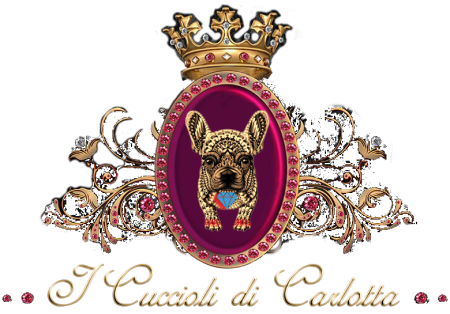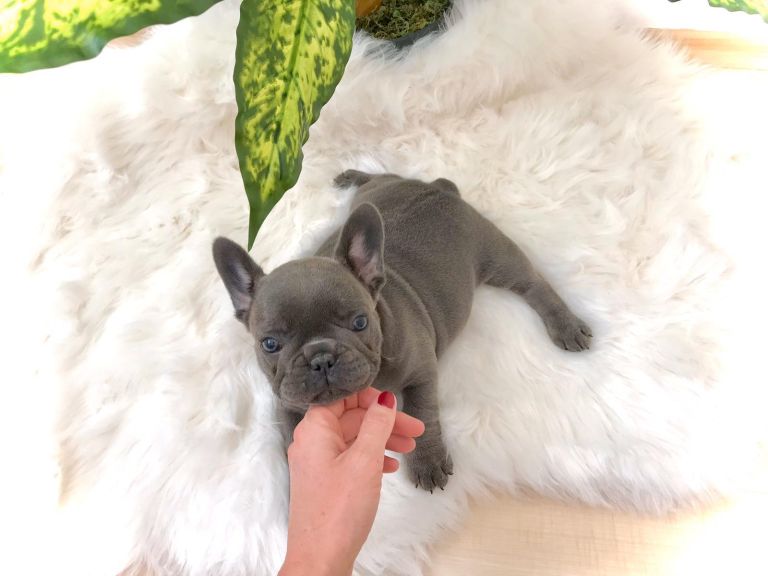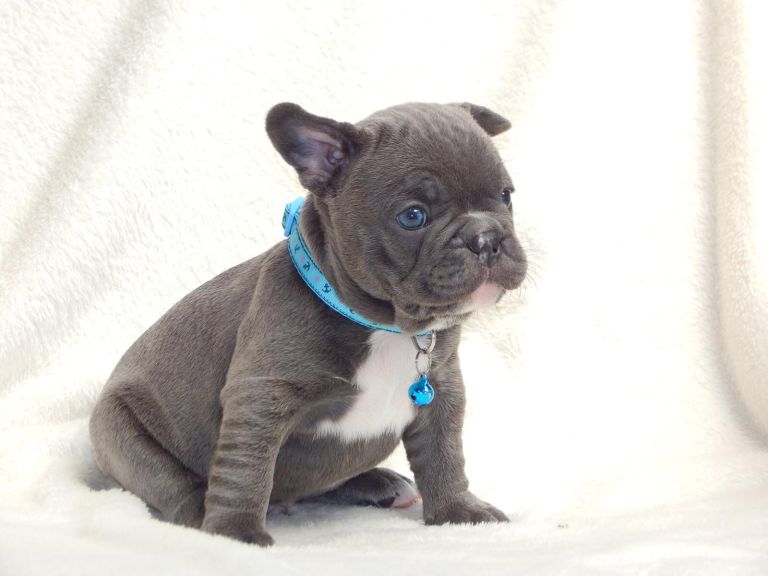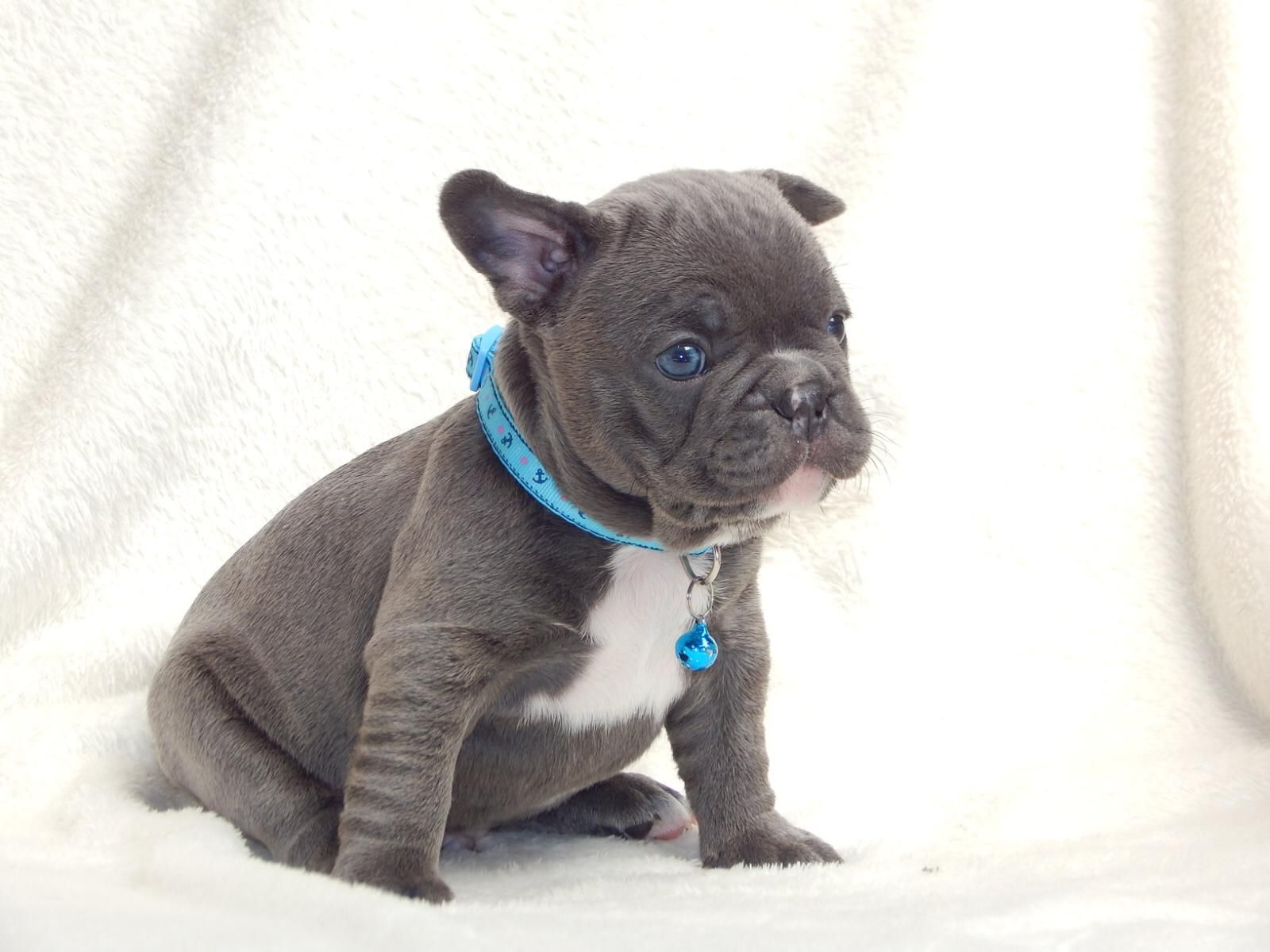Why it's blue: puppies with a rare coat
Why it's blue: puppies with a rare coat This is the result of a particular and very rare genetic variant, the blue French bulldog is a particularly desired dog,its prices may reach very high amounts. The very rare blue coloration is caused by a recessive gene that dilutes the color: it ranges from faded black to bluish gray and tawny blue.
According to the law of conservation of the species, nature preserves the dominant characters of the species. In case of mating of a French bulldog with the character of the blue coat with a specimen of another color, the typical characteristics of the blue genetic variant will be transmitted to the progeny.
This defines the blue French bulldog as suitable for the proper continuation of the species.
Characteristics of the Blue French Bulldog
If we exclude its particular coloring, the blue French bulldog has characteristics similar to those of the common French bulldog: small but at the same time robust, it has a playful and cheerful temperament, excellent as a pet.
Its diet must be taken care of in all essential nutrients, paying attention to the labels if you opt for dry food, and must be educated to obedience as it is an enthusiastic and stubborn dog.
Genetic Aspects of the Blue-Gray French Bulldog
The conservation of favorable individual differences, variations and the destruction of harmful ones have been called by me as" natural selection "or" survival of the fittest ".
The variations that are neither useful nor harmful will not be influenced by the natural selection, and will remain as floating elements, as we may see in certain polymorphic species, or finally, they will be fixed, due to ca If both parents have the same single recessive gene the statistical result of the broods will be the following: 25% no recessive gene; 50% recessive gene; 25% 2 recessive genes.
The small brindle will therefore be partly carriers of the recessive gene and partly not, however, it is still impossible to distinguish them by eye if not following successive mating with subjects carrying the same gene. If one of the 2 parents is the carrier of the autosomal recessive gene that does not manifest itself in reproduction, we can expect that 50% of the puppies will be a carrier of this gene (autosomal is a gene whose locus is not found in the sex chromosomes "X" "Y". All genes that control recessive colors are autosomal.).
Brindle male, without gene x blue, for fawn female with cream gene, will give solid tawny colors, brindle, but all females having fawn will be able to carry in one way or another the dilution gene, both in cream and in blue , therefore the brindle will have fawn as the fawn and here the chances will be very high if this female meets a male with the same gene as the dilute. If one of the 2 parents is a carrier x 2 times of the same autosomal gene, all puppies will have at least one of these genes.
Another example: blue male with tawny female we will only get tawny males and brindle females with cream and non-tawny spots, both will transmit the dilution gene by continuing x redundancy of pairs we will get "Blue feuve" puppies That is red with blue mask, (hardly distinguishable from the classic ), with light eyes and blue / cream with light eyes for the onset of the albinotype phenomenon ".uses dependent on the nature of the organism and on its condition»
(Charles Darwin, The origin of the species, 1859, p. 147)
Blue French bulldogs are highly desired and expensive (think about the fact ,that in the USA, some WEBSITE report amounts up to $ 7,000 per puppy!). These specimens are highly requested, by the way many official canine institutions don’t recognize them in the standard and in the suitable color (being a genetic variant).
However, they could not be so desired in the whole world if they were genetically "failed" dogs.
Therefore, a basic and unscientific consideration is needed: are those people crazy as they buy and loves this genetic variant or perhaps other people didn’t document themselves properly and prefer to listen to people who have every interest in disparaging this beautiful genetic variant?
Aspetti Genetici del Bulldog Francese Blu-Grigio
-
Current veterinary therap
Technical explanations taken from the book "Current veterinary therapy: small animal clinic" (1984, subsequent editions 1996, Italian ed. Piccin Editore) by Robert Warren Kirk.
"First of all, remember that from homozygous subjects recessive by character (cream, blue, cream blue; which are recessive due to the dilution of the color) coupled with recessives they will give only homozygous recessive subjects, while subjects heterozygous for the aforementioned character, therefore, phenotypically black, red or brindle, if coupled together they can also give recessive homozygotes therefore blue, cream blue or cream in the Mendelian proportion of 1: 4.
Let’s remember that from the point of view of a genetic terminology the word Nero is used to indicate several colors, for example Tabby, Chocolate, Brindle etc. which have in common the fact of not being red or orange.The very rare occurrence of the birth of black or blue subjects is explained in this way: these subjects are genetically brindle, but, with a very few red or cream fur, they may have also only small spots on the fingertips or on the palate. There is also the very rare possibility that the explanation should be sought in facts of mutation or altered chromosomal aberration (alteration linked to hetero chromosomes) colors such as. male caille x brindle or caille, will produce brindle male children, white and brindle and equal females, continuing the brindle x brindle mates after a few generations, the subjects tend to lighten or darken too much, so on they will have more and more brindle subjects with little or nonexistent stripe effect and some dilutions as blue / cream. However, these subjects are not albinos, nor with particular diseases, both on the skin and on other species.
The matter is when the dilution of the gene is exacerbated, that is, by continuing the repeated couplings between diluted, this method, which preserves the skin and / or hair color, leads to further dilutions, and may cause the albino type phenomenon, therefore subjects with lack of pigmentation; green or blue eyes with red concentric pupillary.
This redness of the pupil is noted with exposure of the subject to sun exposure or to greater light. Albino subjects may have an important photophobia and skin problems.The same process may occur by introducing cream dogs without black masks into the brindle lines, weakened by excessive coupling between them, in this case we already start with a coupling that denotes a lack of pigmentation at the root. The same triggering factor of skin pathologies, it could be a retrocession in the pairings between subjects, which, over the years had been used to form a breed. For example, it is known that French bulldogs were initially paired with small terriers with large ears held up to correct their plump or pink ears. It is also known that in the bulldog genealogical family there are also pugs ...
Well, the Boston Terrier, for example, has created puppies with more pointed ears, dogs with slimmer build and longer legs, as well as liver-colored puppies and yellow eyes. The coupling with pugs has given thicker hair, with more undercoat, an increase in the already existing skin pathologies in both breeds.
What determines the color of the coat is, or rather, 2 Eumelanin and Feomelanin pigments, these pigments differ in term of chemical structure. The main color is defined by the presence in the hair of the pigment "Eu" i(it s the solid color: black with its recessives); the "Feo" determines the solid red and its diluted one. Disregarding the pigment may create errors. The genes that determine and control the coat's pigment are located on the sex chromosome "X"; the "Y" chromosome doesn’t have it! Starting from the point that the males have chromosome "X" and "Y" their coat is determined by a single pigment .If it is Eumelanin ,we will have males "Eu" and if it is Feomelanin we will have males "Feo", the females unlike two chromosomes "X" and do not have "Y", if both X chromosomes have 2 genes for the Eu there will be females of only one color Eu if both Feo chromosomes the females will be only Feo if the genes are 1 "Feo" el other "Eu" will have Eu- Feo females who will bring both colors in the litters, usually the males take the color of the coat from the mother and inherit the pigments from both parents. The results show the validity of the rules. The recessives appear only after several and excessive mating of the same color, or if, the 2 parents are both carriers of the same recessive gene. Ex: male brindle, son of brindle x cream. Fawn female, daughter of cream x fawn.
If both parents have the same single recessive gene the statistical result of the broods will be the following: 25% no recessive gene; 50% recessive gene; 25% 2 recessive genes. The small brindle will be partly carriers of the recessive gene and partly not, however, it is still impossible to distinguish them by eye if not by following successive mating with subjects carrying the same gene.
If one of the parents is the carrier of the autosomal recessive gene that does not manifest itself in reproduction, we can expect that 50% of the puppies will be a carrier of this gene (autosomal is a gene whose locus is not found in the sex chromosomes "X" "Y". All genes that control recessive colors are autosomal.). Brindle male, without gene x blue, for fawn female with cream gene, will give solid tawny colors, brindle, but all females having fawn will be able to carry in one way or another the dilution gene, both in cream and in blue , therefore the brindle will have fawn as the fawn and here the chances will be very high if this female meets a male with the same gene as the dilute. If one of the parents is a carrier for twice of the same autosomal gene, all the puppies will have at least one of these genes.
Another example: blue male with tawny female we will only get tawny males and brindle females with cream and non-tawny spots, both will transmit the dilution gene by continuing x redundancy of pairs we will get "Blue fau" puppies That is red with blue mask, (hardly distinguishable from the classic ), with light eyes and blue / cream with light eyes for the onset of the albinotype phenomenon ". -
Color and genetics
This is a very interesting field that is showing some changes, as the real genes that influence color are beginning to be located through the chromosomes.
Specific DNA tests can be carried out for the presence of most of the color alleles, particularly when you want to know if there are dilution factors hiding within individuals.
Even if it may seem very complicated, trying to understand the topic and then producing colors from mates and litters with the colors you want.The knowledge of color genetics in the breeding pairs proposed “can help in a way to maximize the desired color combinations. -
General information
Melanocytes are the cells that produce the color of the skin and hair and that are derived from neural cells.These cells arise very early in fetal development and therefore give light to several cell types, including a large part of the peripheral nervous system.
If there is a decrease in the number of neural cells, other cell types are favored, leading to a reduction in melanocyte formation. Melanoblasts (immature color cells) migrate from the dorsal midline to the surface of the body, so that the last areas to be reached are the feet, chest, and muzzle (i.e.it is easier to see white feet, etc.).
Neural cells are also part of the nervous system, for the inner ear and the eye. Animals selected for extreme white streaks (eg Dalmatians) may have hearing and / or deafness. Dalmatian was thought to be the cause of the absence of melanocytes in the vascular stria of the inner ear.
Melanocytes produce melanin from the action of alpha MSH. Large amounts of MSH results in Eumelanine (mainly tyrosine) which produces black or black derivatives (blue, chocolate, brown). The amount of MSH result limited to pheomelanin (contains varying amounts of cysteine and tyrosine), which produce reddish-brown or yellowish tan. The control of melanocyte function is intricate and many loci (genes) have mutations affecting components of melanogenic control mechanisms. -
Color gene
There are about 10 recognized "loci" of different colored genes. Each place can have a variable number of alleles that influence the color result (dilution, pattern, dominant or recessive effects).
All dogs carry these genes, many of those are in a fixed (homozygous) form e.g. Gordon Setter, Elkhounds, etc. In these breeds, quite all loci are fixed and there is a very little color variation in the whole breed. In other breeds, some loci are fixed, while others have a degree of variation (number of alleles) present in other loci. Not all races carry all possible alleles for every locus.
We add here that the colors of the French bulldog are based on different genes that interact with each other, in a way to produce the myriad of colors in which this splendid breed appears.Combinations with other dominant and recessive genes create a hierarchy within the DNA structure. To be expressed and recognized, a recessive gene must be inherited from both mother and father.
If the recessive is inherited from only one of the parents, only the dominant will be expressed, but the puppy will remain the carrier of the recessive gene that can be transmitted to future generations. Since the relative rarity and appropriateness of a Frenchie color is an important factor in determining the price of puppies, it is probably good to have an idea of how the various genes interact.
Without going too much into the speech of DNA that would be confusing, it can be said that the brindle color is dominant compared to the fawn and a uniform color is dominant Caille (white coat with dark-colored spots). Chocolate color is rare and recessive in Frenchies, it is caused by one of the four alleles on locus B (one of which, the most common, cannot be tested for DNA yet). The blue coloring is very rare and is perhaps the most beautiful and strong (gradation ranging from faded black to bluish-gray, fawn blue, or chocolate to lilac): it is also caused by a recessive gene.
Total black without a white bib is also due to a recessive gene such as pure blue (which is created from the double recessive black coupled with the double recessive blue [blue] gene). Blue Frenchies are not allowed in AKC events at this time - but the hope is that the rules will change so that these extraordinarily rare and beautiful dogs may be soon properly admired and rewarded. There is also another color that is even rarer and even more beautiful: the pure black and tan (created by another recessive gene that can also be coupled with a pure blue and tan). -
Current research
Many of the color loci are extensively studied to identify the position of the various genes on the correct chromosome, and subsequently, the alleles are revealed and influence the available color results. From this, DNA markers can be developed and thus allow color DNA testing in various breeds before mating.
The DNA research that is being done right now is set to continue to change our knowledge of the colors genetic.
Let's say that nature (according to Charles Darwin's law of the continuation and preservation of the species) is led to preserve the strongest and predominant characteristics of the species in future dynasties, in any animal hemisphere.
This is shown by nature itself. If we pair a Frenchy that has blue characters with any other color, it will transmit its characters to the progeny because they will be strong and dominant characters and suitable for nature to the perfect and correct continuation of the species.
So, shortly said Blue is a super genuine strong Frenchy! But we have to admit that many breeders have not been able to manage the bloodline and therefore not having it, they prefer to denigrate it and mud it with false legends.
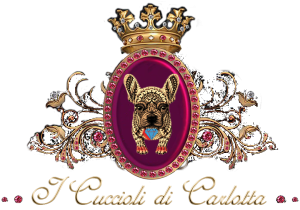
I Cuccioli Di Carlotta , s.r.o.
Durkova 12, 94901 Nitra - Repubblica Slovacca
ICO: 46792147.IC DPH SK2023573013
vlozka cislo: 32303/N. Oddiel Sro
Tutti i diritti sono riservati - I Cuccioli di Carlotta è un marchio depositato e coperto da copyright




